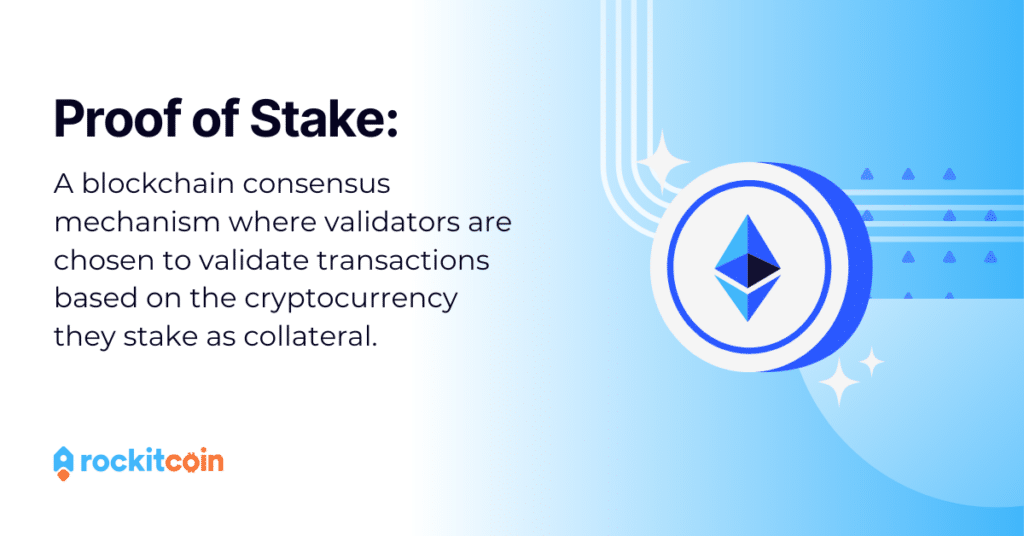Cryptocurrency has transformed how we think about money and digital transactions. At the heart of every cryptocurrency lies a consensus mechanism—a process used to validate transactions and secure the blockchain. Two of the most widely adopted consensus mechanisms are Proof of Work vs Proof of Stake, each with its own unique approach to maintaining blockchain integrity. While both serve the same purpose, they differ significantly in their operations, environmental impact, scalability, and security.
This guide will help you understand Proof of Work vs Proof of Stake, their key differences, and their implications for the future of cryptocurrency.
Key Takeaways
- Proof of Work and Proof of Stake are two methods blockchains use to validate transactions and secure the network.
- Proof of Work relies on mining and high computational power, while Proof of Stake selects validators based on cryptocurrency holdings.
- Both methods have strengths and weaknesses, with Proof of Work excelling in security and decentralization, and Proof of Stake offering better energy efficiency and scalability.
What is Proof of Work (PoW)?

Definition
Proof of Work is the original blockchain consensus mechanism, first implemented by Bitcoin in 2009. It relies on solving complex computational puzzles to validate transactions and add new blocks to the blockchain. This process, known as mining, requires miners to compete using specialized hardware.
How It Works
In PoW systems, miners use powerful computers to solve cryptographic puzzles. The first miner to solve the puzzle gets the right to add a new block of transactions to the blockchain. As a reward, they receive newly created cryptocurrency tokens and transaction fees.
For example, Bitcoin miners compete to solve a cryptographic hash puzzle. The difficulty of this puzzle adjusts based on the network’s activity to ensure consistent block creation times (approximately every 10 minutes for Bitcoin).
Key Features of PoW
- High Security: The immense computational power required to manipulate PoW blockchains makes them highly secure. Fraudulent actions would require control of over 51% of the network’s computing power, a feat nearly impossible for large blockchains like Bitcoin.
- Decentralization: Miners are distributed globally, preventing any single entity from controlling the network.
- Energy Intensive: PoW requires significant energy and computing resources, leading to concerns about environmental sustainability.
Examples of PoW Cryptocurrencies
- Bitcoin
- Litecoin
- Dogecoin
- Ethereum before the Merge (more on Ethereum mining)
What is Proof of Stake (PoS)?

Definition
Proof of Stake was introduced as a more energy-efficient alternative to PoW. Rather than relying on computational puzzles, PoS allows participants to validate transactions based on the amount of cryptocurrency they “stake” as collateral.
How It Works
In PoS systems, users stake their cryptocurrency in exchange for the chance to validate transactions and add blocks to the blockchain. Validators are chosen randomly, with their selection probability proportional to the amount of cryptocurrency they stake. This system eliminates the need for energy-intensive mining.
For instance, Ethereum transitioned to PoS in 2022 with Ethereum 2.0. Validators on the Ethereum network must stake at least 32 ETH to participate in block validation. Users who don’t meet this requirement can delegate their stake to larger pools.
Learn more about what staking cryptocurrency is and how it can help you earn rewards.
Key Features of PoS
- Energy Efficiency: PoS requires significantly less energy compared to PoW, making it environmentally friendly.
- Scalability: By eliminating complex puzzles, PoS enables faster transaction processing.
- Economic Incentives: Validators earn rewards proportional to their stake, encouraging honest participation.
Examples of PoS Cryptocurrencies
- Ethereum 2.0
- Cardano
- Solana
Proof of Work vs Proof of Stake: Key Differences
| Feature | Proof of Work (PoW) | Proof of Stake (PoS) |
| Validation Method | Solving computational puzzles | Staking cryptocurrency |
| Energy Consumption | High energy usage | Low energy usage |
| Hardware Requirements | Specialized hardware (e.g., ASICs) | None |
| Transaction Speed | Slower (e.g., Bitcoin: ~10 min/block) | Faster (e.g., Ethereum 2.0: ~12 sec/block) |
| Decentralization | Highly decentralized | Can trend toward centralization |
| Security | Proven reliability and tamper-resistance | Secure but newer and less tested |
Advantages and Disadvantages of Proof of Work vs Proof of Stake
Proof of Work Advantages
- Security: PoW’s computational difficulty deters attacks.
- Decentralization: Its reliance on distributed miners makes it hard for any single entity to dominate the network.
- Proven Track Record: Bitcoin’s decade-long success demonstrates PoW’s reliability.
Proof of Work Disadvantages
- Energy Consumption: PoW networks consume enormous amounts of energy, contributing to environmental concerns.
- Costly Entry: Mining requires expensive hardware, excluding casual participants.
- Slow Transactions: PoW networks can struggle with scalability due to slower block validation times.
Proof of Stake Advantages
- Energy Efficiency: PoS eliminates the need for high-power hardware, significantly reducing energy use.
- Accessibility: Anyone with cryptocurrency can participate in staking, democratizing the network.
- Faster Transactions: PoS can validate transactions more quickly, supporting higher scalability.
Proof of Stake Disadvantages
- Potential Centralization: Validators with more cryptocurrency have greater influence, leading to concerns about centralization.
- Less Proven: PoS is a newer system and hasn’t been tested on the same scale as PoW.
- Economic Risk: Validators risk losing staked funds if they act dishonestly.
Real-World Applications
- Cryptocurrencies Using PoW: Bitcoin, Litecoin, and Dogecoin.
- Cryptocurrencies Using PoS: Ethereum 2.0, Cardano, and Solana.
Ethereum’s transition from PoW to PoS (known as “The Merge“) highlights the growing preference for energy-efficient mechanisms. This shift reduced Ethereum’s energy consumption by over 99%, demonstrating the potential of PoS.
The Future of Consensus Mechanisms
Both PoW and PoS have strengths and weaknesses, but the cryptocurrency landscape continues to evolve. Emerging mechanisms like Delegated Proof of Stake (DPoS) and Proof of Authority (PoA) aim to combine the best elements of both systems.
For example:
- DPoS: Validators are elected by network participants, enhancing efficiency and reducing centralization risks.
- PoA: Validators are selected based on reputation, offering high transaction throughput.
Why Does It Matter to You?
For investors and users, understanding PoW and PoS helps in making informed decisions about which cryptocurrencies to support. Whether you value security, energy efficiency, or scalability, these mechanisms affect how blockchains function.
At RockItCoin, we make it easy to buy and access cryptocurrencies that use both PoW and PoS. Visit a RockItCoin Bitcoin ATM or use our app to explore Bitcoin, Ethereum, and more.
By understanding PoW and PoS, you’re better equipped to navigate the ever-changing world of cryptocurrency. Whether you’re a beginner or an experienced investor, RockItCoin is here to simplify your journey.
Conclusion
Proof of Work and Proof of Stake are two fundamental consensus mechanisms that power cryptocurrency networks. Proof of Work relies on computational puzzles and high energy usage to secure the blockchain, offering unmatched security and decentralization. In contrast, Proof of Stake provides a more energy-efficient alternative, relying on staked cryptocurrency to validate transactions and scale networks efficiently.
Each mechanism has its strengths and weaknesses. Proof of Work excels in security and reliability but comes with environmental costs. Proof of Stake offers speed and sustainability but is still a relatively new system. Understanding these differences can help you make informed decisions when choosing which cryptocurrencies to support or invest in.
Whether you’re drawn to Bitcoin’s time-tested Proof of Work or Ethereum’s innovative Proof of Stake, RockItCoin makes it easy to access and interact with these cryptocurrencies. Visit one of our Bitcoin ATMs or download the RockItCoin app to explore a seamless and secure way to buy, sell, and manage your digital assets.
Frequently Asked Questions about Proof of Work vs Proof of Stake
What is the main difference between Proof of Work and Proof of Stake?
Proof of Work uses computational puzzles to validate transactions and add new blocks to the blockchain. These puzzles require significant energy and computing power. Proof of Stake, on the other hand, selects validators based on the amount of cryptocurrency they stake as collateral, making it more energy-efficient.
Which is more secure: Proof of Work or Proof of Stake?
Proof of Work is often considered more secure because it relies on computational difficulty, which makes fraudulent actions extremely costly and resource-intensive. Proof of Stake is also secure but newer, relying on financial incentives, such as penalties for bad behavior, to maintain network integrity.
Can I participate in Proof of Stake without staking a large amount of cryptocurrency?
Yes, many Proof of Stake networks allow users to join staking pools. By delegating your cryptocurrency to a validator, you can share in the rewards without meeting the high minimum staking requirements often needed to participate directly.
What cryptocurrencies use Proof of Work and Proof of Stake?
Examples of cryptocurrencies using Proof of Work include Bitcoin, Litecoin, and Dogecoin. Cryptocurrencies that operate on Proof of Stake include Ethereum 2.0, Cardano, and Solana.
Why is Proof of Stake considered more environmentally friendly than Proof of Work?
Proof of Stake eliminates the need for energy-intensive mining hardware and computational puzzles. Validators are selected based on their staked cryptocurrency, not their processing power, resulting in significantly lower electricity usage and a smaller environmental footprint.
What are some risks of participating in Proof of Stake staking?
In Proof of Stake systems, validators can lose a portion of their staked funds if they act dishonestly or fail to maintain their systems properly—a process known as slashing. Additionally, there is a risk of centralization, as wealthier participants with more cryptocurrency can have disproportionate influence over the network.








